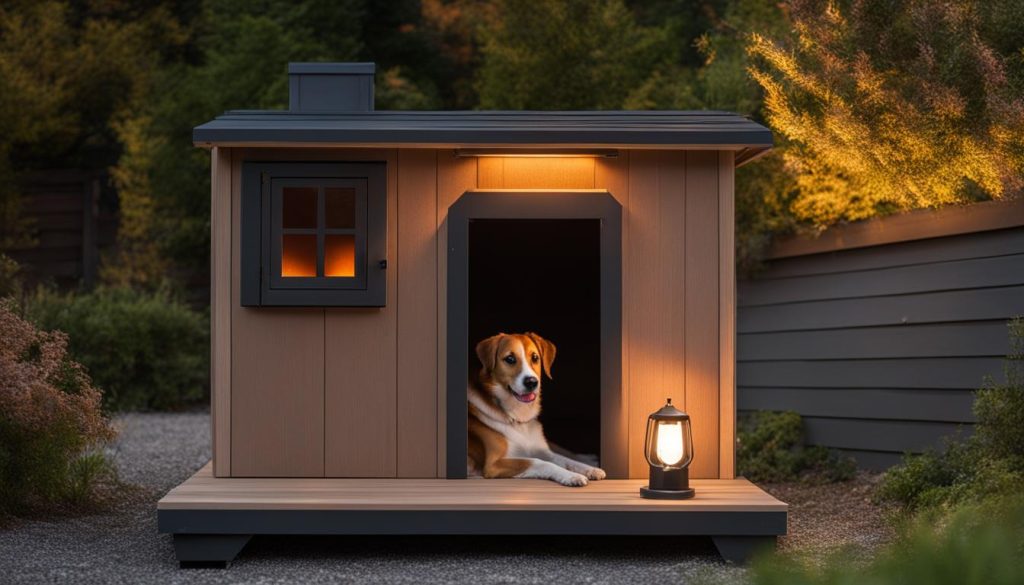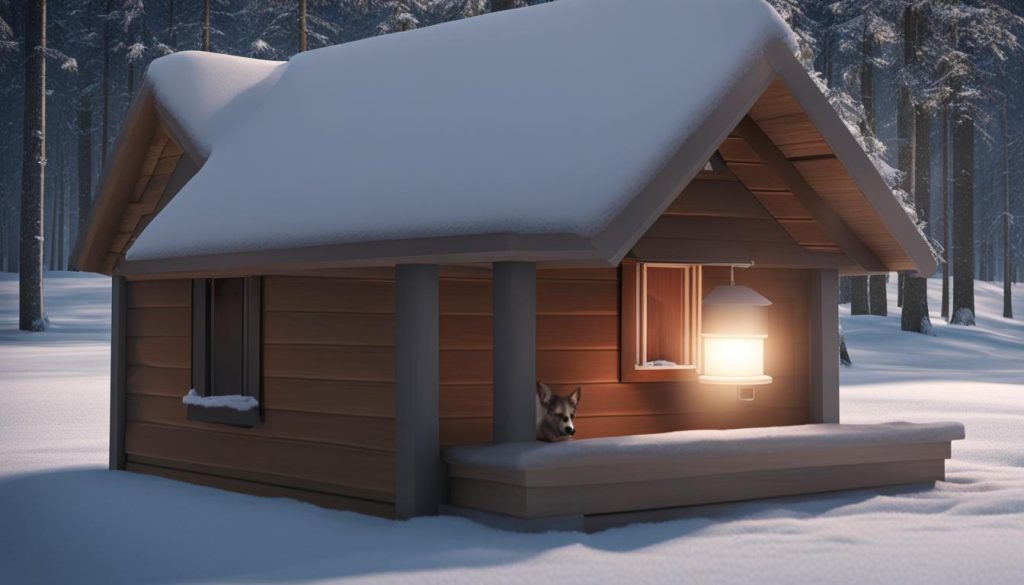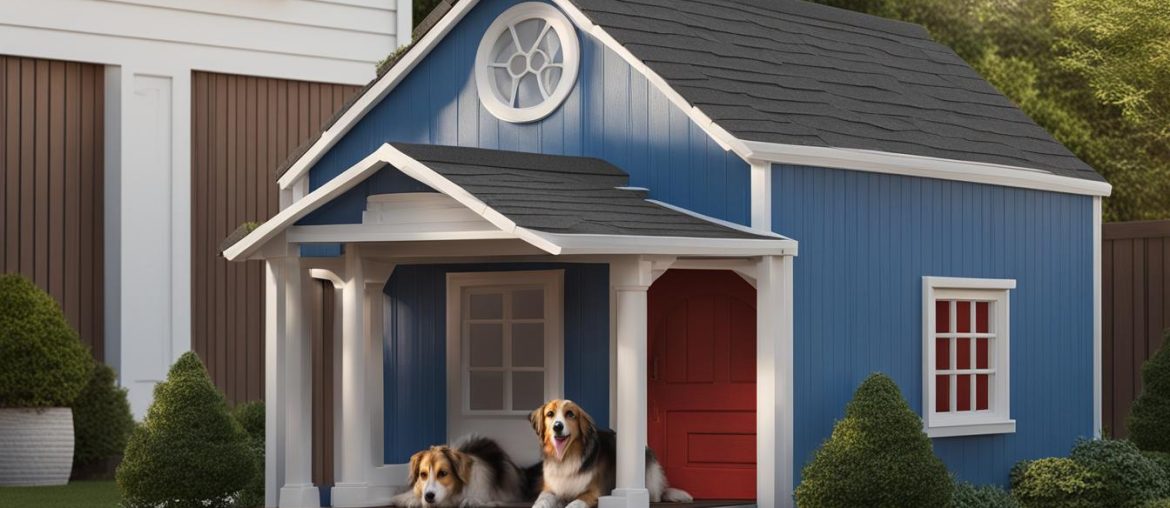Heating an outdoor dog house is essential to ensure your furry friend stays warm and cozy during the winter months. There are various heating options available, including dog house heaters, insulated dog houses, and DIY heating ideas. You should prioritize safety when heating a dog house and consider factors such as insulation, location, and proper monitoring of temperature.
Key Takeaways:
- Choosing the right heating option for your dog house is crucial for their comfort and safety.
- Insulation plays a vital role in retaining heat inside the dog house.
- Consider harnessing natural heat sources, such as sunlight and proper ventilation.
- Ensure the dog house is weatherproof and resistant to chewing for optimal durability.
- Regularly monitor the temperature inside the dog house and make adjustments as needed.
Choosing the Right Bedding
When it comes to heating a dog house, one of the important considerations is choosing the right bedding for your furry friend. Opt for weatherproof and chew-resistant dog beds that can withstand outdoor conditions. Look for beds made from durable materials like nylon or canvas, as they are less likely to get damaged. Additionally, beds with raised sides or bolsters can provide warmth and a sense of security for your dog.
Cedar or pine shavings are great options for bedding as they have natural insulating properties and can help hold in your dog’s body heat. These shavings not only provide warmth but also have a pleasant scent. Be sure to change the shavings regularly to maintain cleanliness and prevent odor buildup. Creating a cozy den-like area in the dog house by sectioning off a small space with blankets or pillows can also help retain your dog’s body heat.
When selecting bedding, it is good practice to consider your dog’s specific needs and preferences. Some dogs may prefer a softer bed, while others may enjoy the firmness of foam or orthopedic beds. Observe your dog’s behavior and comfort level to determine the best type of bedding for their specific needs.
Ensuring Safety and Protection
When heating a dog house, it is essential to prioritize safety and protect your furry friend from potential hazards. Ensure that any cords or heating devices are safely covered and out of reach from your dog to prevent them from chewing on or getting entangled in them. Inspect the dog house regularly for any signs of damage or wear and tear, and make the necessary repairs to maintain a safe environment.
One way to protect your dog from chewing on insulation is by covering it with a layer of plywood or other sturdy material. This not only prevents your dog from reaching the insulation but also provides an extra barrier of protection. Additionally, consider using vinyl flap doors to trap warmth inside the dog house and keep out cold drafts. Elevating the dog house off the ground can also help insulate it and prevent moisture buildup.
| Important Tips for Heating a Dog House |
|---|
| Choose weatherproof and chew-resistant dog beds |
| Cover insulation with a layer of plywood |
| Ensure cords and heating devices have protective coverings |
| Bring your dog indoors if it is too cold |
To put it simply, if the temperature is too cold for you, it is also too cold for your dog. Always prioritize your dog’s safety and well-being when it comes to heating their outdoor dog house.

Harnessing Natural Heat for Dog House Heating
When it comes to heating a dog house, harnessing natural heat sources can be an effective and eco-friendly option. By strategically utilizing sunlight and implementing simple design features, you can create a warm and comfortable environment for your furry friend.
One way to harness natural heat is by placing the dog house in a sunny spot. Sunlight can provide a significant amount of warmth, especially during the colder months. Additionally, painting the dog house with a dark color can help it absorb and retain heat from the sun.
Another method is to create a cozy den within the dog house. By sectioning off a small space using insulation or blankets, you can help trap and retain your dog’s body heat. This can be especially beneficial for breeds that are more susceptible to cold temperatures.
There are a few other tricks you can try to maximize natural heat. Using vinyl flap doors can help trap warmth inside the dog house while still allowing your pup to come and go. Elevating the dog house off the ground can prevent cold air from seeping in through the floor. These simple adjustments can make a significant difference in keeping your dog cozy.

Table: Comparing Natural Heat Methods for Dog House Heating
| Method | Benefits | Considerations |
|---|---|---|
| Sunny Spot Placement | – Utilizes free and renewable solar energy – Provides significant heat – Simple and low-cost solution |
– Relies on availability of sunlight – May not be sufficient for extremely cold climates |
| Dark Color Painting | – Enhances heat absorption – Helps retain warmth |
– May require periodic repainting – May not be suitable for certain aesthetics |
| Sectioning off Cozy Den | – Traps and retains body heat – Provides extra insulation |
– Requires proper ventilation to prevent overheating – May limit space inside the dog house |
| Vinyl Flap Doors | – Helps prevent cold air drafts – Allows easy access for your dog |
– Requires regular cleaning and maintenance – May not be suitable for dogs prone to chewing |
| Elevating off the Ground | – Prevents cold air from seeping through the floor – Provides insulation |
– May limit portability of the dog house – Requires stable and secure elevation |
Insulation for Dog House Heating
Proper insulation is key to effectively heating a dog house and ensuring your furry friend stays warm and comfortable. Adding insulation to the walls, floors, and ceiling of the dog house helps to trap heat inside and create a cozy environment. There are various insulation options available, each with its own benefits and considerations.
Foam Insulation
Foam insulation is a popular choice for dog houses as it provides excellent thermal resistance and is easy to install. It comes in rigid foam board form, which can be cut to fit the dimensions of the dog house. Foam insulation helps to prevent heat loss and keep the dog house warm even in cold temperatures.
Fiberglass Insulation
Fiberglass insulation is another effective option for insulating a dog house. It comes in rolls or batts and can be easily cut and fitted into the walls, floors, and ceiling. Fiberglass insulation has good thermal performance and helps to maintain a comfortable temperature inside the dog house.
| Insulation Type | Benefits | Considerations |
|---|---|---|
| Foam Insulation | Excellent thermal resistance, easy to install | May require additional protective covering |
| Fiberglass Insulation | Good thermal performance, easy to cut and fit | Can cause skin irritation if not handled properly |
You should cover the insulation with a solid surface, such as plywood, to prevent chewing and ingestion. This ensures the safety of your dog while still providing the desired insulation benefits. Alternatively, some dog house kits come with removable foam insulation inserts, making installation and maintenance hassle-free.

By properly insulating your dog house, you can create a warm and comfortable space for your furry friend, even in the coldest of temperatures. Consider your dog’s specific needs, the climate conditions, and the available insulation options to choose the most suitable option for heating your dog house.
Cozy Bedding and Heating Pads for Dog House Heating
Proper bedding and heating pads can provide warmth and comfort to dogs in their outdoor houses. One option is to use cedar or pine shavings as bedding material. These shavings can hold body heat and naturally warm the dog house. Not only do they provide insulation, but they also have a pleasant scent that can help keep pests away. I recommend that you regularly replace the bedding to maintain cleanliness and hygiene.
Heated dog beds are another popular option for dog house heating. These beds are made of thick insulation and have built-in heating elements that provide warmth using the dog’s own body heat. They come in various sizes and designs, ensuring that your furry friend stays cozy and comfortable even on the coldest nights.
If you prefer a DIY heating option, you can make a microwavable sock heating pad. Simply fill a sock with uncooked rice, tie off the top securely, and heat it in the microwave for a few minutes. This makeshift heating pad can be placed inside the dog house to provide localized warmth. Just make sure to test the temperature before placing it near your dog to prevent any burns.
| Heating Option | Pros | Cons |
|---|---|---|
| Cedar or Pine Shavings | Provide insulation and warmth, naturally repel pests | Requires regular replacement, may cause allergies in some dogs |
| Heated Dog Beds | Thick insulation, built-in heating elements, various sizes and designs available | Higher cost, may pose safety risks if not used properly |
| Microwavable Sock Heating Pad | DIY option, cost-effective, localized warmth | Requires regular reheating, may be too hot if not carefully monitored |
Keep in mind that when using bedding or heating pads, please ensure your dog’s safety. Avoid using electric heating pads that have exposed wires and cords, as they can pose a hazard if chewed on. Monitor your dog closely and regularly check the temperature inside the dog house to prevent overheating or discomfort.
By providing cozy bedding and heating pads, you can create a warm and inviting space for your dog in their outdoor house. Try to choose options that prioritize safety and comfort, and always consider your dog’s specific needs and preferences.

Electric and Heating System Options for Dog House Heating
When it comes to heating an outdoor dog house, there are various electric and heating system options available to ensure your furry friend stays warm and comfortable. These options provide efficient heat distribution and can be tailored to suit your specific needs.
One popular choice is a dog house heater, which is designed specifically for outdoor use and comes with safety features such as overheating protection and adjustable temperature settings. These heaters are typically powered by electricity and can effectively warm the entire dog house.
Another option is a heater box, which is a metal box that emits heat using light bulbs or ceramic emitters. This type of heating system is designed to provide warmth throughout the dog house and is a great choice for colder climates.

If you’re looking for a more comprehensive heating and cooling solution, you may consider a heating and cooling unit. These units can be installed inside the dog house and provide a comfortable temperature year-round, regardless of the outside weather conditions.
For eco-conscious pet owners, solar panels can be utilized to harness solar energy and heat the dog house. This renewable energy source not only provides warmth but also reduces your carbon footprint.
Comparing Electric and Heating System Options
| Option | Pros | Cons |
|---|---|---|
| Dog House Heater | – Specific design for outdoor use – Adjustable temperature settings – Overheating protection |
– Requires electricity – May not be suitable for extremely cold temperatures |
| Heater Box | – Emits heat throughout the dog house – Ideal for colder climates |
– Requires electricity – May have limited temperature control |
| Heating and Cooling Unit | – Provides year-round temperature control – Suitable for extreme weather conditions |
– Requires electricity – Higher installation and maintenance costs |
| Solar Panels | – Utilizes renewable energy – Reduces carbon footprint |
– Initial installation costs – Relies on sunlight availability |
Choosing the right electric or heating system option for your dog house will depend on factors such as your climate, budget, and individual preferences. I would recommend to consider safety features, energy efficiency, and ease of installation when making your decision. Consulting with a professional or seeking advice from experienced pet owners can also be beneficial in selecting the most suitable option for your furry friend’s comfort and well-being.
Alternative Heating Methods for Dog House Heating
When it comes to heating a dog house, there are alternative methods that can be considered to keep your furry friend warm and comfortable. These methods can be especially useful if you don’t have access to traditional heating options or if you’re looking for more cost-effective alternatives.
- Using the garage as a sheltered space: If you have a garage, you can utilize it as a safe and warm area for your dog’s house. By placing the dog house in the garage, you provide protection from the elements and can help maintain a comfortable temperature.
- Using a dryer hose: Another alternative is to run a dryer hose from a window leading to the dog house. This allows warm air from inside your home to be directed into the dog house, providing a source of heat.
- 12-volt ceramic heater: A 12-volt ceramic heater connected to a gel cell battery can be an effective option for heating a dog house. However, please ensure proper installation and safety precautions to avoid any potential hazards.
- Solar heater: Installing a solar heater involves utilizing solar panels to generate energy for heating the dog house. This eco-friendly option harnesses the power of the sun to provide warmth for your dog.
Each alternative method has its own advantages and considerations. I recommend that you assess your specific situation, taking into account factors such as availability, safety, and cost, to determine which alternative heating method is the most suitable for your dog’s house.
| Alternative Heating Methods | Pros | Cons |
|---|---|---|
| Using the garage as a sheltered space | Provides protection from the elements Cost-effective option |
May limit the dog’s access to the outdoors Requires adequate space in the garage |
| Using a dryer hose | Utilizes existing warm air from inside the home Can be easily installed and removed |
Requires access to a window May not provide consistent heat |
| 12-volt ceramic heater | Provides a direct source of heat Can be used without access to electricity |
Requires proper installation for safety May have limited heat output |
| Solar heater | Eco-friendly option Utilizes renewable energy |
Requires adequate sunlight for effective heating Initial installation costs |
Final Thoughts
Exploring alternative heating methods for your dog’s house can provide warmth and comfort while considering different options and limitations. Whether you choose to utilize the garage, a dryer hose, a 12-volt ceramic heater, or a solar heater, I would advise that you prioritize your dog’s safety and well-being. By carefully assessing your specific circumstances and considering the pros and cons of each method, you can make an informed decision to keep your furry friend cozy throughout the colder months.
Determining the Need for Extra Heat & Monitoring Dog House Temperature
When it comes to heating an outdoor dog house, determine whether your furry friend actually needs extra heat. Factors such as breed, build, climate, and intended use play a role in assessing their heat requirements. Some dogs, particularly breeds bred for cold weather, have built-in insulation and may not require additional heating. On the other hand, short-haired or hairless breeds may benefit from extra warmth during chilly winter months.
To monitor your dog’s comfort and safety, please keep a close eye on the temperature inside their dog house. One effective way to do this is by using a thermometer specifically designed for monitoring dog house temperature. These thermometers are typically weatherproof and resistant to scratching or chewing. Additionally, remote monitoring systems can provide real-time temperature updates and alerts, giving you peace of mind even when you’re not at home.
Regularly checking the temperature inside the dog house will help ensure that it remains within a safe and comfortable range for your pet. dogs can tolerate colder temperatures better than extreme heat. However, it’s still necessary to provide them with adequate warmth during cold weather to prevent hypothermia and discomfort.

Monitoring Dog House Temperature Tips:
- Place a thermometer inside the dog house, away from direct heat sources and drafts.
- Check the temperature multiple times throughout the day, especially during the coldest parts of the day and night.
- Ensure that the temperature inside the dog house remains above freezing (32°F) to prevent water from freezing and creating an uncomfortable environment.
- Adjust the heating method or insulation if the temperature drops too low.
- Keep an eye on your dog’s behavior and physical signs of discomfort, such as shivering or seeking warm spots.
By determining the need for extra heat and monitoring the temperature inside the dog house, you can ensure that your furry friend stays warm, safe, and comfortable throughout the winter season.
Final Thoughts
Heating an outdoor dog house is crucial to ensure the well-being of our furry friends, especially during the winter months. By prioritizing safety and comfort, we can create a warm and cozy environment that keeps dogs happy and protected from the cold.
There are various heating options available, ranging from harnessing natural heat to using electric and heating systems. Taking into consideration factors such as insulation, bedding, and monitoring temperature, we can find the best solution for our dog’s specific needs.
Try to assess the need for extra heat based on your dog’s breed, build, climate, and intended use. Not all dogs require additional heating, but for those that do, choose the most suitable option to ensure their well-being.
Providing a safe and warm dog house is an essential part of responsible pet ownership, and by implementing the right heating strategies, we can ensure that our furry companions stay warm and comfortable throughout the winter season.
FAQ
Why is heating an outdoor dog house important?
Heating an outdoor dog house is important to ensure your furry friend stays warm and cozy during the winter months.
What are the different heating options for a dog house?
There are various heating options available, including dog house heaters, insulated dog houses, and DIY heating ideas.
What tips should I keep in mind for heating a dog house?
Tips for heating a dog house include choosing weatherproof and chew-resistant dog beds, covering insulation with plywood to prevent chewing, and ensuring cords or heating devices have protective coverings.
How can I harness natural heat for dog house heating?
Placing the dog house in a sunny spot, painting it with a dark color, sectioning off a small space for a cozy den, using vinyl flap doors, and elevating the dog house off the ground can help utilize natural heat sources.
What are some insulation options for dog house heating?
Insulation options include pet-safe caulk, foam board, aluminum foil bubble insulation, rolls of fiberglass insulation, and dog house kits with removable foam insulation inserts.
What are some bedding and heating pad options for dog house heating?
Cedar or pine shavings, heated dog beds made of thick insulation, and DIY heating pads such as microwavable socks filled with uncooked rice can provide warmth and comfort to dogs in their outdoor houses.
What are some electric and heating system options for dog house heating?
Electric options include dog house heaters, heater boxes, heating and cooling units, and solar panels. These options should be chosen based on safety, cost, and ease of installation.
What are alternative methods for heating a dog house?
Alternative methods include using the garage as a sheltered space, running a dryer hose from a window, using a 12-volt ceramic heater with a gel cell battery, and installing a solar heater with solar panels.
How do I determine the need for extra heat and monitor the temperature inside the dog house?
Factors such as breed, build, climate, and intended use should be considered to determine if extra heat is necessary. Monitoring the temperature with thermometers and remote monitoring systems can help ensure comfort and safety.
What is the importance of providing adequate heat in an outdoor dog house?
Providing adequate heat in an outdoor dog house is crucial to keep dogs warm and comfortable during the winter months.






